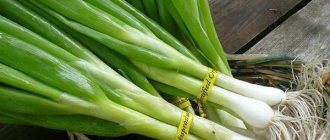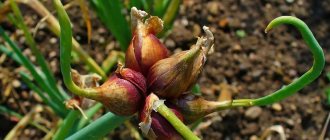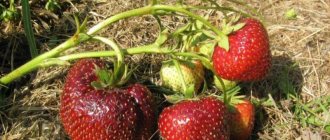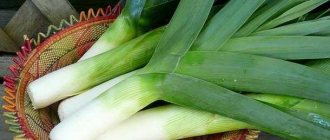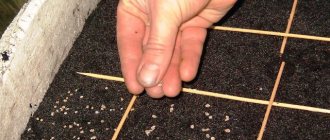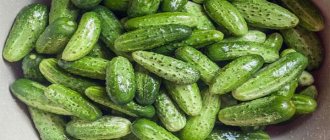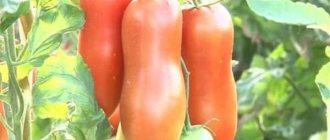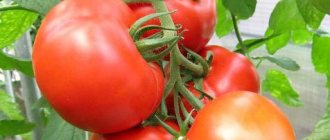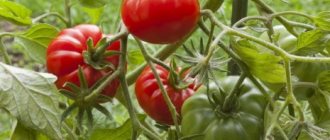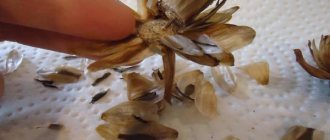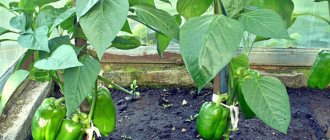Author: Natalya Category: Garden plants Published: February 13, 2019Last edits: January 6, 2021
- When to plant onions in the ground
- How to grow onion
- Onion processing
- Useful properties of onion
Onion (lat. Allium fistulosum), or fistulosum, or tartar, or Chinese onion, or sand , is a herbaceous perennial, a species of the genus Onion. There is an opinion that the homeland of the batun is Asia, since at present it grows wild in China, Japan and Siberia. In culture, this onion is grown everywhere to produce a green feather that has a milder taste than green onions. The bulbs of the batun are oblong and underdeveloped. The thick, hollow inside stem reaches a height of 1 m, the leaves are also fist-shaped, wider than those of onions. The batun blooms with spherical umbrellas consisting of numerous flowers. Onion is propagated by dividing the bush and by seeds. The seedling method of growing spring onions is used if you want to get greens as early as possible, but forgot or were unable to sow them in winter.
Planting and caring for onions
- Planting: sowing seeds for seedlings - in mid-April, planting seedlings in the ground - in mid-June.
- Lighting: bright sunlight or partial shade.
- Soil: fertile, moist sandy loam or loamy soil with slightly acidic or neutral reaction.
- Watering: regular and so abundant that the soil is saturated to a depth of 20 cm. In a normal summer, 2 waterings per week will be enough, but in a drought, the area will have to be moistened every other day.
- Feeding: organic fertilizers in the form of slurry, wood ash and a solution of bird droppings, which can be used to fertilize the baton only once: the plant has the property of accumulating nitrates.
- Reproduction: seed.
- Pests: onion flies, weevils and moths.
- Diseases: downy mildew (downy mildew).
- Properties: has high nutritional value and is used in dietary nutrition.
Read more about growing onions below.
Growing onion from seeds
Sowing onion seeds for seedlings
The most reliable way to get batun is to grow seedlings. The seedling method is very popular in eastern countries, since in an annual crop, spring onions are less affected by powdery mildew, and besides, growing spring onions through seedlings allows you to speed up the ripening process.
Onion seeds are sown in mid-April, and seedlings are planted in open ground in mid-June. In September, green onions are harvested directly from the false bulbs.
The composition of the soil for seedlings should be approximately this: humus and turf soil are mixed in equal proportions, then two glasses of wood ash and 70-75 g of mineral fertilizer for garden plants are added to a bucket of the mixture, after which the composition is thoroughly mixed again. The substrate must be sterilized by heating it in the microwave or steaming it in the oven, or you can simply spill it with a dark pink solution of potassium permanganate.
- Marking F1 on a package of seeds - what does it mean?
Growing leeks - planting and care
Before sowing, onion seeds are soaked for a day in water, changing it every 6 hours, after which they are kept for two or three days in the bottom drawer of the refrigerator, then dried until they flow and sown in a box with a substrate in grooves 8-10 mm deep. The grooves are located at a distance of 4-5 cm from each other. You can sow seeds not in boxes, but 4-6 pieces in pots 4-5 cm in size - this is called the bouquet method of growing seedlings.
The seeds are lightly sprinkled with soil, after which the surface is leveled and compacted, and a layer of clean calcined sand 3 mm thick is poured on top. Then, carefully so as not to wash away the sand, the crops are moistened with a spray bottle, covered with film or glass and kept at a temperature of 18-20 ºC until emergence.
Caring for onion seedlings
As soon as the seeds begin to germinate, the container is exposed to light and kept at a temperature of 9-12 ºC for a week, and then the temperature regime is set to: 13-15 ºC during the day, 10-12 ºC at night. If you can’t lower the temperature, you will have to ventilate the room frequently, protecting the young seedlings from drafts.
For the emerging seedlings, most likely, it will be necessary to organize artificial lighting, since at this time of year it dawns late, gets dark early, and seedlings need a daylight period of 14 hours. A phytolamp or LED source is placed above the seedlings at a height of 25-30 cm. For the first two or three days, artificial lighting should work around the clock, and then it is turned on at 6 and turned off at 20.
Water the onion seedlings moderately, avoiding overmoistening the substrate. A week after seed germination, and then another two weeks later, the seedlings are fed with a solution of 2 g of superphosphate and 2 g of potassium salt in a bucket of water. As soon as the seedlings have their first true leaf, the seedlings need to be thinned out, leaving an interval of about 3 cm between seedlings.
A week before transplanting into open ground, hardening procedures begin: first, the frequency and duration of ventilation are gradually increased, and then, if there is no frost, the seedlings are taken out to the balcony or garden, leaving them there to bask in the sun's rays. When the seedlings can spend time outdoors around the clock, they can be planted in open ground.
How to grow from seeds?
Before planting, the seeds are processed. They need to be soaked in warm water for 3-4 hours and then dried. Next, the algorithm of actions is as follows:
- The beds are being prepared.
- The seeds are deepened by 2 cm at a distance of 3-4 cm. A distance of 20 cm must be maintained between individual rows.
- The soil is leveled with a rake and mulched with humus.
- During germination, weeds are periodically removed and soil moisture is maintained.
- After the first shoots they are thinned out. Between individual plants you need to maintain a distance of 2-3 cm.
- When 3-4 leaves appear, it is necessary to thin out again. The onions should now grow 5-6cm apart.
- At the same time, fertilizing with mineral fertilizers is carried out.
If onion is grown as an annual crop, then there is no need to thin out a second time.
Planting onions in open ground
When to plant onions in the ground
Onion seedlings are planted in the garden bed in mid-June - by this time all the frosts will have passed and the soil will have warmed up to the required depth. Seedlings with a well-developed root system, 3-4 true leaves and a stem thickness at the base of 3-4 mm should be about 60 days old for planting.
Soil for onion
Onions are not as demanding of heat as onions, so they can grow in partial shade. However, this species is more capricious in the choice of soil: the batun needs soil that is fertile, moist, neutral or slightly acidic. Onion grows better on sandy or loamy soils. Despite the fact that the batun prefers damp, low-lying places, do not plant it where water can stagnate, as well as on peat and sandy soils, on which it quickly bolts. The soil is deoxidized by adding wood ash - a half-liter jar for each m² of bed, and this must be done no later than six months before planting.
Planting and caring for shallots - growing seedlings
You need to take responsibility when preparing a site for onions, since the onions are a perennial crop and can grow in one place for 4-5 years. A couple of weeks before planting, 5 kg of compost or humus, 15-20 g of potassium chloride, 30-40 g of superphosphate, 25-30 g of ammonium nitrate are added to each m² of plot, and then the bed is dug up and leveled.
After which you can plant onion
Growing onions will be much more successful if you plant them in the place where green manure, peas, beans, cabbage or tomatoes used to grow, but after crops such as onions, garlic, carrots and cucumbers, it is better not to plant the onions.
How to plant onions in open ground
Planting spring onions is done in the same way as planting seedlings of any other type of onion. Dig holes in the area at a distance of 10-12 cm in the row and 20 cm between the rows and plant the seedlings in them. If you sowed the seeds using the bouquet method, take this into account when preparing the holes and place them more spaciously in the garden bed.
Planting onions before winter
You can sow spring onions in open ground three times per season: in April, in June-July and in October-November. Pre-winter sowing of onions is carried out in order to obtain their greens next spring as early as possible. The area for onions is prepared in the summer, and as soon as stable cold sets in and the air temperature drops to 3-4 ºC, onion seeds are sown thickly to a depth of 2 cm if the soil in the garden bed is heavy, and to a depth of 3 cm if the soil is light. The distance between rows is approximately 20 cm.
After sowing, the area is mulched with peat for the winter. With the onset of spring, it is advisable to cover the bed with the batun crops with plastic wrap - this measure will speed up the germination of seeds. Winter onions begin to germinate as soon as the snow melts. Slightly grown seedlings need to be thinned out.
- Watermelon: growing from seeds in the garden, varieties
Onion on the windowsill
Vitamin-rich spring onions can be grown in the middle of winter on your own windowsill. To do this, you need to dig up two- or three-year-old bushes in the fall along with a lump of earth, transplant them into pots or containers with any nutritious soil and keep them at high air humidity (about 80%) and a temperature of 18-22 ºC - in three weeks you will already have fresh greens.
Growing onions for greens on the windowsill
You can grow spring onions at home from seeds or from small sets, but it is easier and faster to get feathers from bulbs. When growing a loaf from seeds, you will get your first greens no earlier than in a month and a half, and onion feathers from the sets will be ready for cutting in 2-3 weeks. However, the lifespan of the bulb is only 2 months, and a feather grown from seeds can be cut off within two years, if you do not forget to fertilize the soil 1-2 times a month - 1 capful of Growth is dissolved in 2 liters of water and the substrate is moistened with the solution in a pot.
Before sowing, the seeds are soaked overnight in clean water, then they are kept for 8 hours in a pink solution of potassium permanganate and sown to a depth of 2-3 cm in a container with a drainage layer and nutrient soil - a mixture of vermicompost (1 part) and coconut fiber (2 parts). The container is covered with polyethylene and kept at a temperature of 18-25 ºC, and as soon as shoots appear, the cover is removed and the temperature is lowered to 12-18 ºC.
Onion grows from seeds very slowly, and the first cutting can be done in two months. It is likely that you will have to organize artificial lighting for the onions to extend the daylight hours by 3-4 hours.
For forcing, small onions are selected and planted closely in a nutrient substrate poured into pots or boxes in a layer of 15 cm. The bulbs are covered with the same substrate on top, watered and placed in a bright but cool place - the optimal temperature for forcing onions from sets 12 -18 ºC.
Features of the plant
Onion is a perennial herbaceous plant belonging to the Onion family. It is also called Tatarka, onion, etc. As a wild plant, it is widely represented in Siberia, the islands of Japan and China.
The green onions are juicier and more tender in comparison with onions, which is why they are widely cultivated in our country; they are not planted except in the Far North. The spring onion does not form the usual onion; it is replaced by a slight thickening - a false onion.
Interest in this perennial plant - a source of onion greens - is associated with its high yield, unpretentiousness and resistance to low temperatures.
Growing spring onions does not require much hassle.
You can grow a plant in one place for no more than 5 years. During this time, the onion bushes will grow - each onion plant will form 4-5 daughter plants in just 1 year, forming up to 30 branches per bush.
If the seeding is excessively thickened, the following problems naturally arise:
- feathers become small;
- the quality of the crop deteriorates.
To eliminate them, the following methods are used:
- overgrown bushes of the plant are divided into several parts and planted in beds, increasing the yield of onion greens;
- overgrown bushes are dug out along with a lump of soil and planted in greenhouses or greenhouses for forcing in the winter.
Onion care
How to grow onion
Growing and caring for onions is not difficult and includes procedures familiar to any gardener - watering, loosening the soil, weeding, fertilizing and protection from diseases and pests.
The first loosening is carried out as soon as the seedlings take root, but in the first year you will need to loosen the soil around the plants at least 5-6 times - after each watering or rain. Simultaneously with loosening the soil, weeds are removed. You can significantly make your work easier and free up a lot of time if you mulch the area with peat - in this case, you will have to water, loosen, and weed much less often. They begin to cut onion greens when they grow 10-15 cm.
Watering onions
The moisture-loving onion requires regular moistening of the soil; the soil must be saturated with moisture to a depth of 20 cm. In normal summer weather with a normal amount of precipitation, two waterings per week will be sufficient, but during periods of drought you will have to water the onion every other day. Keep in mind that watering should be done with non-cold water, which should be poured at the root.
Growing onions in open ground - planting and care
Fertilizing onions
A week after planting the seedlings in the garden bed, a solution of mullein in a ratio of 1:10 or bird droppings in a ratio of 1:15 is added to poor soil; if the soil is fertile, the bushes and the soil around them are dusted with wood ash. You can fertilize the baton with a solution of manure only once, since the plant tends to accumulate nitrates, and therefore, in the future, the baton is fed with wood ash, which is not only a fertilizer, but also a good preventative against diseases and pests.
Planting onions in the garden
Since it is easier to grow onion from seeds, you need to decide on the sowing time. After all, this can be done not only in spring, but also in autumn. They also choose another time for sowing the plant.
The rules for planting onions include:
- preparation of beds and seed material;
- choice of planting density;
- care of planted material.
Both perennial and annual types of batun are grown by seeds. In one place, a perennial crop can grow for seven years without losing its beneficial qualities. For annuals, the planting site is changed annually, without leaving it in the same area.
Preparing seeds before planting
Onion propagates both by seeds and vegetatively. But preference is given to seeds, since when they are planted, the varietal qualities of the vegetable are preserved.
Seed germination is slow, so before sowing in the ground, planting material is soaked in cool water and left for a day. It is worth changing the water twice. After hardening, the seeds are dried.
To speed up the emergence of seedlings, place a bag of nigella in a solution with complex fertilizers. A warm solution of potassium permanganate will protect the seed from the action of pathogenic microorganisms.
Thanks to proper seed preparation, onion sprouts will appear within a week or ten days.
Seed sowing pattern and depth
The method of planting a perennial plant is a two-line tape method. A gap of seventy centimeters is left between the tapes. The distance in the row should not be large, because the bulb does not form, so 10–15 centimeters is enough. The planting norm is considered to be 1.5–2.0 grams per square meter. In cold weather, the density increases to three grams per square meter.
The grains are buried 2–3 centimeters into the ground. The crops are sprinkled with a layer of mulch. After the seeds are buried, the soil is slightly compacted, and after a week the beds need to be loosened.
Timing of sowing seeds
Annual plant varieties are planted as soon as the snow melts, in the first half of March. In Siberia, sowing time is the end of March.
You can postpone planting seeds until the summer. But they sow so that the vegetable has time to grow before the cold weather. When you plan to sow onions in June, the vegetable will ripen in May.
But when you want to plant a batun in the fall, for the winter, then they select the weather so that the plant does not freeze, sprouting ahead of time.
The green mass is harvested depending on the time of sowing. Autumn planting will allow you to collect succulent feathers only in mid-summer.
Annuals are valued for the large amount of feathers they produce during the growing season. But perennial varieties do not require constant planting. The batun was planted, and in the second year they began to trim the leaves. Useful foliage is collected twice during the season.
Pests and diseases of onion
Subject to the conditions of agricultural technology, onions are almost not affected by diseases or pests, but sometimes troubles still happen. For example, the batun can suffer from onion weevils, moths and flies.
The onion moth eats the inside of onion leaves, leaving behind a thin skin. At the first signs of the appearance of a pest, plants are treated with a contact insecticide - Karbofos or Fufanon, but for some time after treatment, onions should not be eaten.
The onion weevil, a bug 2-2.7 mm long, makes punctures on the leaves of the onion and through them feeds on the sap of the plant. And weevil larvae gnaw holes in the leaves, causing them to turn yellow and disappear.
The onion fly is not much different from the well-known house fly, but it causes much more trouble. The fly larvae gnaw through the bulb and eat out cavities in it.
Among the diseases, onion can be affected by peronosporosis, or downy mildew. The infection covers the leaves with gray-purple mold and they die. The most effective remedy for this fungal disease is 2-3 treatments of plants with a solution of HOM or copper sulfate with an interval of 10 days. However, the most effective method is not always the safest.
- Preparing amaryllis for the dormant period
Onion processing
The best way to protect onions from pests and fungal diseases is to comply with the agrotechnical conditions for growing the crop, preventive measures and proper care - regular destruction of weeds and loosening of the soil. If you are careful, you will be able to detect signs of disease or the appearance of pests on onions at the very beginning, and then to get rid of the problem it will be enough to apply folk remedies to them - not as radical as solutions of fungicides and insecticides, but not toxic.
We offer you several recipes for folk remedies that will help you expel pests and destroy the infection on onions:
- from moths: treat the onion leaves with a strong solution of mustard powder;
- from pests: in May-June, give the onions a cold shower in the garden;
- from onion fly: 2-3 times per season, spray the plants with a solution of a glass of salt in a bucket of water;
- from pests and diseases: from early spring, treat onions leaf by leaf with infusions of potato tops, tomatoes, garlic peels or onions.
But before treating onions for diseases or pests, remove affected leaves and plants from the garden bed.
Diseases and pests
The dried above-ground part of the onion is a sign of disease or pest infestation. Any disease begins gradually. First, the feather loses its green color, a coating forms on the false bulb, and it softens.
Onion leaves dry out due to insects: adults - adults and their larvae. Perennial onions are threatened by:
- onion fly;
- thrips;
- lurker.
Good care, which consists of regular watering, annual spring feeding, weeding, loosening, serves as the prevention of onion diseases. Insects are repelled using safe folk recipes: tobacco dust, ash mixed with mustard powder, dandelion infusion.
Cleaning and storing onions
Onions are grown exclusively for their greenery. This plant does not form a real bulb; a thickening forms in the soil, which is called a false bulb. Onions can be grown in one place for up to 10 years, but the most productive are the first 3-4 years, and then, due to the numerous daughter plants that onions form, the plantings become too dense, and this reduces the quality of the crop.
In the first year, onion grows roots that can go 30 cm deep. Greens are cut from mid-summer to autumn. In subsequent years, feathers begin to be cut off in early spring, about a month after green shoots appear. Stop cutting a month and a half before the start of frost, so that the underground organs have time to prepare for winter. In just one season, the crop can be harvested 2 to 4 times.
The greens are ready for cutting when they reach a height of 20 to 25 cm. Cutting is done at ground level, then the leaves are tied into bunches, cooled and stored in the refrigerator wrapped in plastic.
How to properly grow garlic in open ground
If you need to preserve onion bulbs dug up in the fall until forcing, keep them at a temperature no higher than 1 ºC, but do not trim the leaves on the bulbs.
When to plant onions in the fall
Pre-winter sowing of batun is carried out after the appearance of a stable cold snap and freezing of the soil to 3–4 °C. Climatic conditions in most regions where garden crops are grown allow such work to be carried out from the beginning of September until about mid-December.
Sowing dates by region: table
| Cultivation region | Sowing dates |
| Moscow and region | Until the end of October |
| Central Russia | All September to mid-October |
| Ural | Until mid-October |
| Siberia | No later than the first ten days of October |
| Southern regions | The beginning of November |
In accordance with the lunar calendar, you need to sow “Tatara” in the fall on the following favorable days: September 1, 8, 27–28 and October 6–7, 25, as well as November 2–3, 21–22 and 29–30.
Types and varieties of onions
Onions are grown in Ukraine, Moldova, Russia, Mongolia, China, Japan, Western Europe and North America. Onion varieties are divided into two subspecies - Japanese and Russian.
Russian onion leaves have a dark green color and a pungent taste; they reach a height of 30-40 cm and quickly become coarse. Plants of this subspecies are highly branched, so they are grown in one place for no longer than four years. These varieties are propagated by seeds and by dividing the bush. The advantage of onion varieties belonging to the Russian variety is their high frost resistance. The Russian subspecies is represented by the following varieties:
- Maysky is a late-ripening, strongly branching onion with a pungent taste, weighing from 200 to 340 g, which does not freeze even in snowless winters, when the temperature drops to 45 ºC. The bulb of plants of this variety is elongated, poorly expressed, the outer scales are dark brown;
- Gribovsky 21 is a high-yielding variety with light green leaves of excellent taste and late bolting;
- Trinity is a mid-season winter-hardy variety of semi-sharp taste with delicate green leaves covered with a waxy coating of medium intensity;
- Russian winter onion - a mid-season, winter-hardy salad variety with a mildly pungent taste and strongly branching leaves up to 50 cm high;
The Japanese subspecies includes plants of medium height with delicate leaves of a semi-sharp taste that droop at the top. Japanese varieties are also winter-hardy, although they are inferior in this quality to varieties of the Russian subspecies. The Japanese variety of onion is divided into four varieties - Ro, Senju, Kujo and Kaga. Varieties of the Kaga and Ro types are very similar to each other - they have a semi-sharp taste, medium power and differ only in early ripening. Senju-type varieties, the most common in Japan, have powerful leaves with a mildly pungent taste and a delicate scent and a false stem reaching a height of 60-75 cm.
Kudze varieties have small leaves with a semi-sharp taste and are grown both indoors and outdoors. The most famous varieties of the Japanese variety include:
- spring onion April 12 is an early-ripening, frost-resistant, semi-sharp and disease-resistant variety with an elongated bulb and large, delicate leaves that do not harden for a long time. Plant weight from 200 to 300 g;
- Long Tokyo is a mid-season, winter-hardy, productive variety with a pungent taste with erect, delicate leaves up to 60 cm long with a slight waxy coating;
- Long white koshikaya is a productive winter-hardy mid-season variety of semi-sharp taste with long and wide erect tender leaves with a waxy coating;
- Saladny 35 is a semi-sharp, early-ripening, frost-resistant variety, resistant to disease, which in the second year produces two or three branches with five dark green, tender and juicy, long-lasting, non-coarsening leaves up to 50 cm long. The harvesting period of this variety is short because it starts shooting early.
Other varieties of onion are also popular in cultivation. For example:
- Ural Family is an early ripening variety with a semi-sharp taste, technical ripeness of which occurs 25 days after germination. This is a plant up to 50 cm high, which has many false stems and delicate green leaves with a yellowish tint and a waxy coating;
- Tenderness is a productive mid-season frost-resistant salad variety with a mildly pungent taste with a powerful, erect, branched rosette up to 40 cm high, made of green tender leaves with a barely noticeable waxy coating;
- Parade is a mid-season variety of Dutch selection, forming a rosette of bluish-green leaves with a faint waxy coating up to 60 cm high;
- Molodets is a productive and winter-hardy early-ripening variety of semi-sharp taste with erect bluish-green leaves up to 45 cm long with a strong waxy coating;
- Performer is a mid-season variety of average yield with erect bluish-green juicy and tender leaves up to 50 cm high with a strong waxy coating and a slightly pungent taste;
- Emerald is an early-ripening winter-hardy salad variety, resistant to disease, with tender and juicy dark green leaves with a strong waxy coating. This variety is a hybrid between spring onions and onions;
- Krasauvets is a new fruitful, frost-resistant, early-ripening variety, resistant to diseases and producing delicate, long-lasting greenery with a pleasant semi-sharp taste, up to 60 cm high;
- Baron is an early-ripening variety with a slightly pungent taste, up to 65 cm high, forming many false stems with delicate dark green leaves with a waxy coating;
- Ladoga is a mid-season salad variety with a delicate, slightly pungent taste with a rosette of erect leaves up to 50 cm high;
- Red snowdrop is an early-ripening, productive, frost-resistant variety with delicate, succulent leaves up to 30 cm long.
Recommendations for agricultural technology
Planting material for this variety is offered by many large agricultural companies in our country. For propagation, you can also use seeds collected from your own plants, but in order to maintain the yield and stability of the variety at the proper height, the seed stock should be regularly updated, giving preference to trusted producers. As a rule, such seeds undergo special preparation, which guarantees fast and friendly germination; stimulation of growth in the early stages; plant resistance to weather stress and diseases; uniformity of products and improvement of the taste of greens.
In the photo - onion seeds of the "April" variety in packages from various manufacturers
Batun is cultivated both as a perennial crop, with 2-3 (up to 5) cuttings of greenery for each growing season, and as an annual crop, removing leaves 25-30 cm high along with the roots. In the conditions of the Moscow region, when growing “April” onion from seeds, it is recommended to sow in spring, summer (June - July) and, as an exception, before winter. According to reviews, autumn crops (September) often die during overwintering, despite the frost resistance of the variety. In addition, according to the observations of gardeners, at the same spring or summer sowing time, the fewer seeds are sown per unit area, the more bolting plants there are. The degree of bolting in the second year and subsequent years of the growing season directly depends on the overall development and intensity of branching. When sowing is thickened and carried out at a later date, the yield of green feathers in the spring of next year is lower.
For propagation, non-seedling and seedling methods with sowing seeds are used, as well as the vegetative method of dividing bushes, planting daughter shoots. To force feathers in winter, batun is grown in greenhouses, greenhouses, and at home, for example, on window sills. In the fall, onion sods are harvested and planted as needed. You can read more about methods of growing spring onions in the article on our website.
Like other representatives of the crop, “April” is demanding on soil fertility. It is best suited to light, slightly and medium loamy soils with neutral acidity. To increase productivity at the beginning of summer, in order to stimulate the growth and development of green mass, it is advisable to feed onions with mature organic matter (fresh manure cannot be used) or other nitrogen fertilizers. In autumn it is recommended to add phosphorus and potassium. Mineral complexes (NPK) have a positive effect on the yield of green onions.
At home, you can prepare seedlings or grow trumpet to obtain year-round greenery
In caring for plants, standard agrotechnical measures are used: watering, weeding, regular loosening of the soil, thinning of plantings. For perennial onions that have entered the bolting phase (if it is not planned to obtain seeds), the flower stalks must be cut off until their height exceeds 10-12 cm.
Properties of onion
Useful properties of onion
Onion has all the benefits of onion, but its vitamin C content is higher. The leaves of the batun contain in abundance nicotinic acid, riboflavin, carotene, thiamine, potassium, magnesium and iron salts, essential oil, which gives the onion a special aroma and bitter taste. The properties of the onion are of greatest value in the spring, when many people suffer from vitamin deficiency, because 150 g of the onion can replenish half the daily requirement of vitamins C and A and a fifth of the required amount of potassium and calcium, which improve the functioning of the cardiovascular system.
Carotene contained in onion greens helps maintain skin and mucous membranes in good condition. Chinese doctors use onion as a diaphoretic, analgesic, anthelmintic, tonic, disinfectant, hemostatic and tonic.
Nutritionists include this type of onion in the diet of people who have metabolic disorders, liver disease, kidney stones, gout, atherosclerosis, hypertension and dysentery.
To treat fever, diseases of the cardiovascular system and gastrointestinal tract, a tincture of onion is used, which is made as follows: chopped onion is poured with seventy percent alcohol in a ratio of 1:4, infused for a week and filtered. Drink the tincture, diluting 15-20 drops in 50 ml of water.
How and when to plant winter onions in the ground
For those who suffer from rapid fatigue, a decoction of spring onion will help: chop 80 g of greens, pour 200 ml of boiling water over it, let it brew for half an hour under the lid, strain and take 200 ml twice a day after meals.
Onion - contraindications
Overeating onions can lead to nervous overexcitation. It is undesirable to eat onions for those who suffer from pancreatitis, gastritis, stomach and duodenal ulcers.
Sowing perennial onions in spring
As a perennial plant, batun can be planted with seeds both in winter and in spring, in early May, and in summer. If the planting becomes thicker, the seedlings are thinned out, leaving a distance of 6-7 cm. Already in July, you can get the first onion greens that can be cut.
If onion is cultivated as a perennial plant in the fall, the feathers cannot be cut off.
Next year, the old leaves need to be removed, and in 25-30 days the first harvest of onion greens will be ready. And after 60 days you will harvest a new harvest of feather onions.
